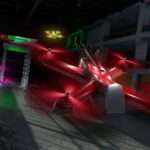PRE-FLIGHT CHECKLIST
How to Fly
There are four main drone controls:
Hello, drones are vehicles that require attention and seriousness to fly. during flight
The chance of intervention from the ground to a problem that may occur is very limited. A safe flight
and before the flight, during the flight and in order to perform the desired work.
It is necessary to carry out very meticulous checks afterwards. Careless checks and adjustments
loss of footage and drone may result in injury
Ensure that apparatus such as antennas and cables that can become entangled in the air
It should be checked that it is fixed. It is also important that the propellers are installed correctly and not loose.
generation drones ensure that the direction of rotation of the propellers is opposite to the installation direction of the engine.
with safety measures that will cause the propeller to tighten even if it is loose
equipped but still ensure that the propellers are firmly in place prior to flight.
should be checked.
Before flying the drone, all parts are checked one by one, all parts are working and
Make sure that the drone is standing firmly on it. All cables plugged in
It should be checked whether there is a broken or corroded cable. battery is properly seated
should be seen.
Pre-Flight: Checking the Communication between the Drone and the Controller
Pre-Flight: Checking Battery Status of Drone, Remotes and Monitors
Pre-Flight: Weather Check
Pre-Flight: Checking the Takeoff and Landing Area

WEATHER & SITE SAFETY CHECK
- Chance of precipitation less than 10%
- Wind speed under 15 knots (less than 20 mph)
- Cloud base at least 500 feet
- Visibility at least 3 statute miles (SM)
- If flying at dawn / dusk, double-check civil twilight hours
- Establish take-off, landing, and emergency hover zones
- Potential for electromagnetic interference?
- Look for towers, wires, buildings, trees, or other obstructions
- Look for pedestrians and/or animals and set up safety perimeter if needed
- Discuss flight mission with other crew members if present
VISUAL AIRCRAFT / SYSTEM INSPECTION
- Registration number is displayed properly and is legible
- Look for abnormalities—aircraft frame, propellers, motors, undercarriage
- Look for abnormalities—gimbal, camera, transmitter, payloads, etc.
- Gimbal clamp and lens caps are removed
- Clean lens with microfiber cloth
- Attach propellers, battery/fuel source, and insert SD card / lens filters
POWERING UP
- Turn on the remote control and open up DJI Go 4 app
- Turn on aircraft
- Verify established connection between transmitter and aircraft
- Position antennas on transmitter toward the sky
- Verify display panel / FPV screen is functioning properly
- Calibrate Inertial Measurement Unit (IMU) as needed
- Calibrate compass before every flight
- Verify battery / fuel levels on both transmitter and aircraft
- Verify that the UAS has acquired GPS location from at least six satellites
TAKING OFF
- Take-off to eye-level altitude for about 10-15 seconds
- Look for any imbalances or irregularities
- Listen for abnormal sounds
- Pitch, roll, and yaw to test control response and sensitivity
- Check for electromagnetic interference or other software warnings
- Do one final check to secure safety of flight operations area
- Proceed with flight mission








